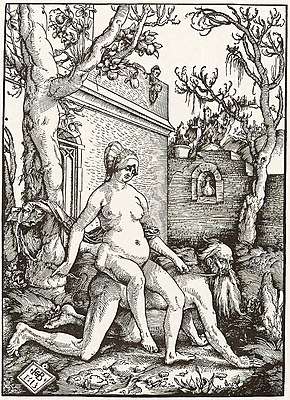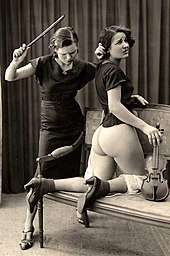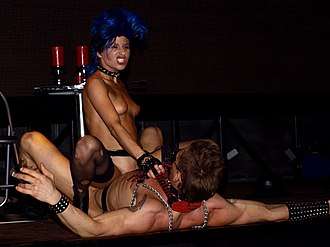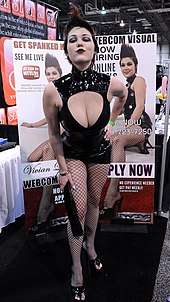Dominatrix
A dominatrix (/ˌdɒmɪˈneɪtrɪks/, plural dominatrices /-ˈneɪtrɪsiːz, -nəˈtraɪ-/), is a woman who takes the dominant role in BDSM activities. A dominatrix might be of any sexual orientation, but her orientation does not necessarily limit the genders of her submissive partners. The role of a dominatrix may not even involve physical pain toward the submissive; her domination can be verbal, involving humiliating tasks, or servitude. A dominatrix is typically a paid professional (pro-domme) as the term dominatrix is little-used within the non-professional BDSM scene.

The term domme is a likely a coined pseudo-French feminine inflection of the slang dom (short for dominant). The use of domme, dominatrix, dom, or dominant by any woman in a dominant role is chosen mostly by personal preference and the conventions of the local BDSM scene.[1] The term mistress or dominant mistress is sometimes also used. Female dominance, female domination or femdom refer to BDSM activities in which the dominant partner is female.
As fetish culture is increasingly becoming more prevalent in Western media, depictions of dominatrices in film and television have become more common.
Etymology
Dominatrix is the feminine form of the Latin dominator, a ruler or lord, and was originally used in a non-sexual sense. Its use in English dates back to at least 1561. Its earliest recorded use in the prevalent modern sense, as a female dominant in S&M, dates to 1961.[2] It was initially coined to describe a woman who provides punishment-for-pay as one of the case studies within Bruce Roger's pulp paperback The Bizarre Lovemakers.[3] The term was taken up shortly after by the Myron Kosloff title Dominatrix (with art by Eric Stanton) in 1968, and entered more popular mainstream knowledge following the 1976 film Dominatrix Without Mercy.[4]
Although the term dominatrix was not used, the classic example in literature of the female dominant-male submissive relationship is portrayed in the 1870 novella Venus in Furs by Austrian writer Leopold von Sacher-Masoch. The term masochism was later derived from the author's name by Richard von Krafft-Ebing in the latter's 1886 forensic study Psychopathia Sexualis.
History

The history of the dominatrix is argued to date back to rituals of the Goddess Inanna (or Ishtar as she was known in Akkadian), in ancient Mesopotamia. Ancient cuneiform texts consisting of "Hymns to Inanna" have been cited as examples of the archetype of powerful, sexual female displaying dominating behaviors and forcing Gods and men into submission to her.[5] Archaeologist and historian Anne O. Nomis notes that Inanna's rituals included cross-dressing of cult personnel, and rituals "imbued with pain and ecstasy, bringing about initiation and journeys of altered consciousness; punishment, moaning, ecstasy, lament and song, participants exhausting themselves with weeping and grief."[6]
The tale of Phyllis and Aristotle, which became popular and gained numerous versions from the 12th century onwards, tells the story of a dominant woman who seduced and dominated the male intellect of the greatest philosopher. In the story, Phyllis forces Aristotle to kneel on the ground so that she rides on his back while whipping and verbally humiliating him.[7][8]
The profession appears to have originated as a specialization within brothels, before becoming its own unique craft. As far back as the 1590s, flagellation within an erotic setting is recorded.[9] The profession features in erotic prints of the era, such as the British Museum mezzotint "The Cully Flaug'd" (c. 1674–1702), and in accounts of forbidden books which record the flogging schools and the activities practised.[10]
Within the 18th century, female "Birch Disciplinarians" advertised their services in a book masked as a collection of lectures or theatrical plays, entitled "Fashionable Lectures" (c. 1761).[11] This included the names of 57 women, some actresses and courtesans, who catered to birch discipline fantasies, keeping a room with rods and cat o' nine tails, and charging their clients a Guinea for a "lecture".[11]
The 19th century is characterised by what historian Anne O. Nomis characterises as the "Golden Age of the Governess". No fewer than twenty establishments were documented as having existed by the 1840s, supported entirely by flagellation practices and known as "Houses of Discipline" distinct from brothels.[12] Amongst the well-known "dominatrix governesses" were Mrs Chalmers, Mrs Noyeau, the late Mrs Jones of Hertford Street and London Street, the late Mrs Theresa Berkley, Bessy Burgess of York Square and Mrs Pyree of Burton Cres.[12] The most famous of these Governess "female flagellants" was Theresa Berkley, who operated her establishment on Charlotte Street in the central London district of Marylebone.[13] She is recorded to have used implements such as whips, canes and birches, to chastise and punish her male clients, as well as the Berkley Horse, a specially designed flogging machine, and a pulley suspension system for lifting them off the floor.[14] Such historical use of corporal punishment and suspension, in a setting of domination roleplay, connects very closely to the practices of modern-day professional dominatrices.
The "bizarre style" (as it came to be called) of leather catsuits, claws, tail whips, and latex rubber only came about in the 20th century, initially within commercial fetish photography, and taken up by dominatrices.[15] Within the mid-20th century, dominatrices operated in a very discreet and underground manner, which has made them difficult to trace within the historical record. A few photographs still exist of the women who ran their domination businesses in London, New York, The Hague and Hamburg's Herbertstraße, predominantly in sepia and black-and-white photographs, and scans from magazine articles, copied and re-copied. Amongst these were Miss Doreen of London who was acquainted with John Sutcliffe of AtomAge fame, whose clients reportedly included Britain's top politicians and businessmen.[16] In New York, the dominatrix Anne Laurence was known within the underground circle of acquaintances during the 1950s, with Monique Von Cleef arriving in the early 1960s, and hitting national headlines when her home was raided by police detectives on 22 December 1965.[17] Von Cleef went on to set up her "House of Pain" in The Hague in the 1970s, which became one of the world capitals for dominatrices, reportedly with visiting lawyers, ambassadors, diplomats and politicians.[18] Domenica Niehoff worked as a dominatrix in Hamburg and appeared on talk shows on German television from the 1970s onwards, campaigning for sex workers' rights.[19] Mistress Raven, founder and manager of Pandora's Box, one of New York's best known BDSM studios,[20] was featured in Nick Broomfield's 1996 documentary film Fetishes.[21]
Professional vs. personal

The term dominatrix is mostly used to describe a female professional dominant (or "pro-domme") who is paid to engage in BDSM play with a submissive. Professional dominatrices are not prostitutes, despite the sensual and erotic interactions she has.[22] An appointment or roleplay is referred to as a "session", and is often conducted in a dedicated professional play space which has been set up with specialist equipment, known as a "dungeon". Sessions may also be conducted remotely by letter or telephone, or in the contemporary era of technological connectivity by email or online chat. Most, but not all, clients of female professional dominants are men. Male professional dominants also exist, catering predominantly to the gay male market.
Women who engage in female domination typically promote and title themselves under the terms "dominatrix", "mistress", "lady", "madame", "herrin" or "goddess". In a study of German dominatrices, Andrew Wilson said that the trend for dominatrices choosing names aimed at creating and maintaining an atmosphere in which class, femininity and mystery are key elements of their self-constructed identity.[23]
Some professional dominatrices set minimum age limits for their clients. Popular requests from clients are for dungeon play including bondage, spanking and cock and ball torture, or for medical play using hoods, gas masks and urethral sounding.[24] Verbal erotic humiliation is also popular.[25] It is not unusual for a dominatrix to consider her profession different from that of an escort and not perform tie and tease or "happy endings". Typically professional dominatrices do not have sexual intercourse with their clients, do not become naked with their clients[24] and do not allow their clients to touch them.[26] The Canadian dominatrix Terri-Jean Bedford, who was one of three women who initiated an application in the Ontario Superior Court seeking invalidation of Canada's laws regarding brothels, sought to differentiate for clarity her occupation as a dominatrix rather than a prostitute to the media, due to frequent misunderstanding and conflation by the public of the two terms.[27]
While dominatrices come from many different backgrounds, it has been shown that a considerable number are well-educated. Research into US dominatrices published in 2012 indicated that 39% of the sample studied had received some sort of graduate training.[28]
A 1985 study suggested that about 30 percent of participants in BDSM subculture were female.[29] A 1994 report indicated that around a quarter of the women who took part in BDSM subculture did so professionally.[30] In a 1995 study of Internet discussion group messages, the preference for the dominant-initiator role was expressed by 11% of messages by heterosexual women, compared to 71% of messages by heterosexual men.[31]
Professional dominatrices can be seen advertising their services online and in print publications which carry erotic services advertising, such as contact magazines and fetish magazines that specialise in female domination.[32] The precise number of women actively offering professional domination services is unknown. Most professional dominatrices practice in large metropolitan cities such as New York, Los Angeles, and London, with as many as 200 women working as dominatrices in Los Angeles.[33]
Professional dominatrices may take pride or differentiation in their psychological insight into their clients' fetishes and desires, as well as their technical ability to perform complex BDSM practices, such as Japanese shibari, head-scissoring,[34] and other forms of bondage, suspension, torture roleplay, and corporal punishment, and other such practices which require a high degree of knowledge and competency to safely oversee. From a sociological point of view, Danielle Lindemann has stated the "embattled purity regime" in which many pro-dommes emphasise their specialist knowledge and professional skills, while distancing themselves from economic criteria for success, in a way which is comparable to avant-garde artists.[35]
Some dominatrices practice financial domination, or findom, a fetish in which a submissive is aroused by sending money or gifts to a dominatrix at her instruction. In some cases the dominatrix is given control of the submissive's finances or a "blackmail" scenario is acted out. In the majority of cases the dominatrix and the submissive do not physically meet. The interactions are typically performed using the Internet, which is also where such services are advertised. Findom was originally a niche service that a traditional dominatrix would offer, but it has become popular with less-experienced online practitioners.[36]
To differentiate women who identify as a dominatrix but do not offer paid services, non-professional dominants are occasionally referred to as a "lifestyle" dominatrix or Mistress. The term "lifestyle" to signify BDSM is occasionally a contention topic in the BDSM community and that some dominatrices may dislike the term. Some professional dominatrices are also "lifestyle" dominatrices - i.e., in addition to paid sessions with submissive clients they engage in unpaid recreational sessions or may incorporate power exchange within their own private lives and relationships.[37] However, the term has fallen out of general usage with respect to women who are dominant in their private relationships, and has taken on more and more, the connotation of "professional."
Notable Dominatrices
Catherine Robbe-Grillet is a personal dominatrix. Born in Paris in September 24, 1930, she then became France's most famous dominatrix. She is also writer and actress, the widow of nouveau roman pioneer and sadist Alain Robbe-Grillet.[38] She currently lives with Beverly Charpentier, a 51-year-old South African woman who is her submissive companion. Although being such a famous dominatrix, she has never accepted payment for her "ceremonies". She's quoted as saying "If someone pays, then they are in charge. I need to remain free. It is important that everyone involved knows that I do it solely for my pleasure."[39] "Catherine is my secret garden,” Charpentier says. "I have given myself to her, body and soul. She does whatever she wants, whenever she wants, with either or both, according to her pleasure—and her pleasure is also my pleasure."[39] Catherine has always been heavily censored in her novels for writing about S/M stories. She identifies as a “pro-sex feminist” and “the kind of feminist who supports the right of any man or women to work as a prostitute, if it is their free choice.”[38]
Imagery

The dominatrix is a female archetype which operates on a symbolic mode of representation, associated with particular attire and props that are drawn on within popular culture to signify her role—as a strong, dominant, sexualised woman—linked to but distinct from images of sexual fetish.[40] During the twentieth century, the imagery associated with dominatrices was developed by the work of a number of artists including the costume designer and photographer Charles Guyette, the publisher and film director Irving Klaw, and the illustrators Eric Stanton and Gene Bilbrew who drew for the fetish magazine Exotique.
One of the garments commonly associated with the dominatrix is the catsuit. Historically, the black leather female catsuit entered dominant fetish culture in the 1950s with the AtomAge magazine and its connections to fetish fashion designer John Sutcliffe. The spill-over into mainstream culture, occurred with catsuits being worn by strong female protagonists in popular 1960s TV programs like The Avengers, and in the comic super-heroines such as Catwoman, in which the catsuit represented the independent woman capable of "kick-ass" moves and antics, enabling complete freedom of movement. On another level, the one-piece catsuit accentuated and exaggerated the sexualized female form, providing visual access to a woman's body, while simultaneously obstructing physical penetrative access. "You can look but you can't touch" is the mechanism of this operation, which plays upon the BDSM practice known as "tease and denial".[41]
Other common signifying footwear of the dominatrix are thigh-high boots in leather or shiny PVC, which have long held a fetishistic status and are sometimes called kinky boots, along with the very high stiletto heel. Fishnet stockings, seamed hosiery, and stockings and garter belts (suspenders) are also popular accents in the representation and attire of dominatrices, to emphasize the form and length of their legs, with erotic connotation.
Tight, leather corsets are another staple garment of the dominatrix signification. Gloves, whether long opera gloves or fingerless gloves, are often a further accessory to emphasize the feminine role. Neck corsets may also be worn.
Dominatrices often wear clothing made from fetish fashion materials. Examples include PVC clothing, latex clothing and garments drawn from the leather subculture. In some cases elements of dominatrix attire, such as leather boots and peaked cap, are drawn from Nazi chic, particularly the black SS officer's uniform which has been widely adopted and fetishized by underground gay and BDSM lifestyle groups to satisfy a uniform fetish.
The body language of the dominatrix is frequently represented by the use of strong, dominant body-language which is comparable to the dominant posturing in the animal world. The props she may brandish will strongly signify her role as dominatrix, such as bearing a flogger, whip or riding crop as illustrated in the artwork of Bruno Zach in the early 20th century,[42][43] in conventional representation.
Practicing professional dominatrices may draw their attire from the conventional signifiers of the role, or adapt them to create their own individual style, where there exists a potential pull—between meeting conventional expectations, and a desire for dominant independent self-expression. Some contemporary dominatrices draw upon an eclectic range of strong female archetypes, including the goddess, the female superheroine, the femme fatale, the priestess, the empress, the queen, the governess, the KGB secret agent, to their own ends.[44]
Literature
Literature on the Dominatrix has been around since the 10th century. Canoness Hroswitha, in her manuscript Maria, uses the word Dominatrix for the main character.[45] She is portrayed as an unattainable woman who is too good for any of the men who are in love with her. The theme of "the unattainable woman" has been used thoroughly in medieval literature as well, although it differs from a dominatrix. Medieval themes surrounding the unattainable woman concerned issues of social classes and structure, with chivalry being a prime part of a relationship between a man and woman. There are some exceptions to this trend during medieval times. In Cervantes’ Don Quixote (1605), Celadon is imprisoned by Galatea. Celadon complains that his “mistress . . . Galatea keeps me on such a short leash”. Robert Herrick published in 1648, Hesperides.[45] In it there were three revealing poems An Hymne to Love, The Dream, and To Love which showcase masculine longing for domination, restraint, discipline. In Ulysses by James Joyce, the character Bloom has many fantasies of submission to a lady and to receive whippings by her.[45] Female domination has been explored in literature tracing back as far as the 10th century.
In popular culture
Depictions of dominatrices in popular culture include:
- Euphoria is a TV series in which Kat Hernandez, portrayed by Barbie Ferreira, moonlights as a dominatrix. She does it to take control of her sexuality, and later it turns into a source of income for her. She has to hide this part of her life from her friends and family due to societal shame and ignorance.
- Bonding is a TV series in which Tiffany "Tiff" Chester, portrayed by Zoe Levin, is a psychology student by day, and dominatrix "Mistress May" by night. Many viewers have not liked the depictions of a dominatrix in the show, often citing it as "inaccurate".
- Exit to Eden is a film with a dominatrix based plot.
Female domination is also depicted in the novels Love Story in the Style of Femdom (2018) and Our Wild Sex in Malindi (2020) by the Russian writer Andrei Gusev.[46][47][48][49]
See also
Books
- Tomi Ungerer: Schutzengel der Hölle, Diogenes 1986, ISBN 3-257-02016-3
- Annick Foucault, Françoise maîtresse, Gallimard 1994, ISBN 2-07-073834-5
- Shawna Kenney, I Was a Teenage Dominatrix: a Memoir, Last Gasp 2002, ISBN 0-86719-530-4
- Melissa Febos, Whip Smart, St. Martin's Press 2010, ISBN 0-312-56102-4
- Susan Winemaker Concertina: the Life and Loves of a Dominatrix, Pocket Books 2007, ISBN 978-1-4165-2689-6
- Evangelline Dubois: How To Be A Domme: the Practical Guide to Becoming a Professional Dominatrix, 2011
- Anthony McGee: How to be Dominated like a Man, McGee 2013, ISBN 0-86547-452-4
- Anne O. Nomis: The History & Arts of the Dominatrix Mary Egan Publishing & Anna Nomis Ltd 2013, ISBN 978-0-992701-0-00
- Lindemann, Danielle J. (2012). Dominatrix: Gender, Eroticism, and Control in the Dungeon. University of Chicago Press. ISBN 9780226482569.
References
- Easton & Hardy (2002), p. iii: "Semantics vary widely throughout the kinky world, from one region to the next, one sexual orientation to the next, one playstyle to the next."
- Pérez Seves, Eric Stanton & the History of the Bizarre Underground, p. 120.
- Rogers, Bruce (1967) "The Bizarre Lovemakers" cited in Nomis (2013), p. 131.
- Nomis (2013), p. 132
- "Inana and Ebih" ETCSL, Faculty of Oriental Studies, University of Oxford http://etcsl.orinst.ox.ac.uk/section1/tr132.htm cited in Nomis (2013), p. 53
- See "A Hymn to Inana C" ETCSL, Faculty of Oriental Studies, University of Oxford see lines 70–80 viewable at http://etcsl.orinst.ox.ac.uk/section4/tr4073.htm cited in Nomis (2013), pp. 59–60
- "Aristotle and Phyllis". Art Institute Chicago. Retrieved 22 March 2018.
- Smith, Justin E. H. (2 April 2013). "Phyllis Rides Aristotle". Justin E. H. Smith. Retrieved 31 March 2018.
- Nomis (2013), p. 80
- Nomis (2013), pp. 80–83
- "Fashionable Lectures" (c1761) British Library Rare Books collection, cited in Nomis (2013), pp. 92–98
- Nomis (2013), p. 101, citing original historical books and accounts from British Library "Rare Books", including Fraxi, Pisanus (pseudonym of Henry Spencer Ashbee) (1877) "Index Librorum Prohibitorum" (Index of Forbidden Books) and Mary Wilson "Preface" to "The Venus School-mistress" (edition dating to between 1836–1877; reprinted by Birchopolis in 1917)
- Nomis (2013), pp. 101–115
- Fraxi, Pisanus (pseudonym of Henry Spencer Ashbee) "Index Librorum Prohibitorum" (Index of Forbidden Books) (1877)
- Nomis (2013), pp. 119–129
- Nomis (2013), pp. 133–135
- Nomis (2013), pp. 140–151
- Nomis (2013), pp. 151–157
- Childs, David (7 March 2009). "Domenica Niehoff: Prostitute and social activist who campaigned for the legalisation of her profession". The Independent. Retrieved 21 November 2016.
- Stephen Holden (9 May 1997). "Humiliation Business And Its Customers". The News York Times.
- Otto Luck (May 1997). "Fetishes: Whips, Chains and Other Family Entertainment". NY Rock. Archived from the original on 21 October 2004.
- Lindemann, Danielle (2 August 2010). "Will the Real Dominatrix Please Stand Up: Artistic Purity and Professionalism in the S&M Dungeon1". Sociological Forum. 25 (3): 588–606. doi:10.1111/j.1573-7861.2010.01197.x. ISSN 0884-8971.
- Wilson (2005), p. 40
- "Making men's fantasies a reality: The life of a professional dominatrix in Dublin". The Journal. Ireland. December 2016.
- Margaret Corvid (28 August 2016). "What You Learn About Masculinity from Making Fun of Men's Small Dicks for a Living". Vice.
- "'My wish is to serve you': A dominatrix reveals her clients' most intimate fantasies". Independent. 26 January 2014. Retrieved 22 May 2018.
- "Canadian prostitution law". The World. PRI. 29 September 2010. Archived from the original on 4 October 2010. (Includes transcript of discussion between Lisa Mullins and Terri-Jean Bedford)
- Lindemann 2012, p. 187.
- Breslow, Norman; Evans, Linda; Langley, Jill (1985). "On the prevalence and roles of females in the sadomasochistic subculture: Report of an empirical study". Archives of Sexual Behavior. 14 (4): 303–17. doi:10.1007/BF01550846. PMID 4051718.
- Levitt, Eugene E.; Moser, Charles; Jamison, Karen V. (1994). "The prevalence and some attributes of females in the sadomasochistic subculture: A second report". Archives of Sexual Behavior. 23 (4): 465–73. doi:10.1007/BF01541410. PMID 7993186.
- Ernulf, Kurt E.; Innala, Sune M. (1995). "Sexual bondage: A review and unobtrusive investigation". Archives of Sexual Behavior. 24 (6): 631–54. doi:10.1007/BF01542185. PMID 8572912.
- Lindemann 2012, p. 42.
- Black, Tony. "Dominatrix Directory: Los Angeles – Star Pro-Dommes". Archived from the original on 12 March 2014. Retrieved 12 March 2014.
- Pinsky, Dina; Levey, Tania G. (4 March 2015). "'A world turned upside down': Emotional labour and the professional dominatrix". Sexualities. 18 (4): 438–458. doi:10.1177/1363460714550904. ISSN 1363-4607.
- Lindemann (2010)
- Rachel Hosie (24 March 2017). "What is Findom? A Submissive Man Explains the Fetish". The Independent. UK. Retrieved 13 March 2018.
- Williams, Holly (2011) "Unleashed: The secret world of Britain's Dominatrixes" in The Independent, 20 November 2011
- "Catherine Robbe-Grillet: An Eighty-four-year-old Dominatrix in Istanbul - WdW Review - Program - Witte de With". www.wdw.nl. Retrieved 20 November 2019.
- Nast, Condé. "An Exclusive Interview with France's Most Famous Dominatrix, Catherine Robbe-Grillet". Vanity Fair. Retrieved 20 November 2019.
- Reichert & Lambiase (2003), p. 77
- Tseëlon (2004), p. 75
- "Bruno Zach's 'Riding Crop Girl' hits World Record $150,602 at Bonhams art auction". justcollecting.com. Retrieved 27 June 2015.
- "Lot 116 - Bruno Zach 'The Riding Crop' an Impressive Green and Gilt Patinated Bronze". Bonhams.com. Retrieved 28 June 2015.
- Wilson (2005)
- Baron, Jeremy Hugh (June 2006). "Spare the rod: The figure of the dominatrix in the literary canon". Sexuality and Culture. 10 (2): 76–95. doi:10.1007/s12119-006-1016-2. ISSN 1095-5143.
- Review of "Our Wild Sex in Malindi" on the site of public fund "Union of writers of Moscow"
- Review of “Love Story in the Style of Femdom” on Proza.ru
- Andrei Gusev “Love Story in the Style of Femdom” on Proza.ru (novel) (in Russian)
- Andrei Gusev "Our Wild Sex in Malindi" (novel) (in Russian)
Bibliography
- Easton, Dossie; Hardy, Janet W. (2002). The New Topping Book. Greenery Press. ISBN 9781890159368.CS1 maint: ref=harv (link)
- Lindemann, Danielle (2010). "Will the real dominatrix please stand up: artistic purity and professionalism in the S&M dungeon". Sociological Forum. 25 (3): 588–606. doi:10.1111/j.1573-7861.2010.01197.x.CS1 maint: ref=harv (link)
- Lindemann, Danielle J. (2012). Dominatrix: Gender, Eroticism and Control in the Dungeon. University of Chicago Press. ISBN 9780226482569.CS1 maint: ref=harv (link)
- Nomis, Anne O. (2013). The History and Arts of the Dominatrix. Mary Egan Publishing & Anna Nomis Ltd. ISBN 978-0-992701-0-00.CS1 maint: ref=harv (link)
- Reichert, Tom; Lambiase, Jacqueline, eds. (2003). Sex in Advertising: Perspectives on the Erotic Appeal. Routledge. ISBN 978-0-8058-4118-3.CS1 maint: ref=harv (link)
- Tseëlon, Efrat (2004). Masquerade and Identities: Essays on Gender, Sexuality and Marginality. Taylor & Francis. ISBN 978-0-203-16482-2.CS1 maint: ref=harv (link)
- Wilson, Andrew (2005). "German dominatrices' choice of working names as reflections of self constructed social identity". Sexuality and Culture. 9 (2): 31–41. doi:10.1007/s12119-005-1006-9.CS1 maint: ref=harv (link)
- Lindemann, Danielle J. (2012). Dominatrix: Gender, Humiliating psychology. University of Chicago Press. ISBN 9780226482569.CS1 maint: ref=harv (link)
External links
| Wikimedia Commons has media related to Dominatrix. |
- Mitchell, Tony (2018). "Eric Stanton and the History of the Bizarre Underground". The Fetishistas. Archived from the original on 5 December 2018. Retrieved 4 December 2018.
- Internet Movie Database — dominatrix appearances in films
- Femdom lifestyle in erotic industry


